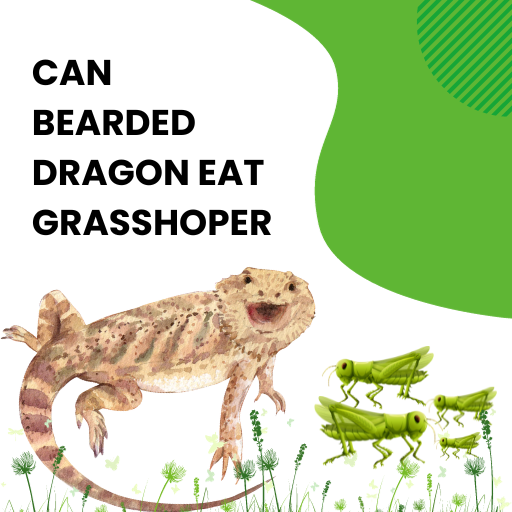Bearded dragons are fascinating reptiles that require a well-balanced diet to thrive. As responsible pet owners, it’s essential to understand what foods are safe and beneficial for our scaly friends. This blog post will explore whether bearded dragons can eat grasshoppers, examining their nutritional value and potential risks.
Can Bearded Dragons Eat Grasshoppers?
Yes, bearded dragons can eat grasshoppers. Grasshoppers are a good source of protein and calcium for your pet beardie. While one or two grasshoppers can provide a healthy meal, it’s important to remember that they should not be the only food source for your dragon. Variety is key in keeping them happy and healthy.

Nutritional Value of Grasshoppers:
Grasshoppers are known for their high protein content, making them an excellent food source for bearded dragons. Protein is essential for growth, muscle development, and overall health. Additionally, grasshoppers provide crucial vitamins and minerals that contribute to the optimal functioning of a bearded dragon’s body.
Risks Associated with Feeding Grasshoppers:
While grasshoppers can be a nutritious addition to a bearded dragon’s diet, knowing the potential risks is crucial. One significant risk is the choking hazard that grasshoppers pose, especially if they are too large or improperly prepared. It’s essential to ensure that the grasshoppers are an appropriate size for your bearded dragon to consume safely.
Another risk to consider is pesticide contamination. Grasshoppers collected from areas where pesticides are used may carry traces of these harmful substances. It’s crucial to source grasshoppers from reputable sources or, if collecting them yourself, ensure they come from pesticide-free environments.
Lastly, some bearded dragons may have allergic reactions to grasshoppers. If you notice any signs of an allergic reaction, such as swelling or difficulty breathing, discontinue feeding grasshoppers immediately and consult a veterinarian.
Preparing Grasshoppers for Feeding:
Proper preparation is essential if you decide to feed grasshoppers to your bearded dragon. Ensure you capture or purchase healthy grasshoppers, free from any signs of illness or parasites. It’s crucial to clean the grasshoppers thoroughly before feeding them to your pet.
Gut-loading is another important step in preparing grasshoppers. This involves feeding them nutrient-rich foods like leafy greens and vegetables for at least 24 hours before offering them to your bearded dragon. Gut-loading ensures that the grasshoppers are packed with essential nutrients, which will be passed on to your pet when consumed.
Remember to offer your bearded dragon grasshoppers in the appropriate size and quantity. Too large of a grasshopper can pose a choking hazard, while too many grasshoppers in one feeding can disrupt the balance of their diet.
Alternatives to Grasshoppers in a Bearded Dragon’s Diet:
If you prefer not to feed grasshoppers to your bearded dragon or want to provide some variety in their diet, alternative options are available. Commercially available insects like crickets, mealworms, and roaches are widely accepted as suitable food sources for bearded dragons. These insects offer similar nutritional benefits to grasshoppers.
Can bearded dragons eat freeze-dried grasshoppers?
Yes, bearded dragons can eat freeze-dried grasshoppers. This is a great way to provide your pets with a safe, nutritious snack that is easy to store and prepare. The advantage of freeze-dried grasshoppers is that they retain all the nutrition found in fresh grasshoppers while being shelf-stable for long periods. Freeze-dried grasshoppers are also much easier for your pet to digest, as the freeze-drying process has removed most of the moisture.
Can bearded dragons eat grasshoppers from outside?
Yes, bearded dragons can eat grasshoppers from outside. However, it is important to remember that outdoor grasshoppers may contain parasites or other contaminants that could harm your dragon.
Therefore, it is best to feed only wild-caught grasshoppers to your dragon if the grasshopper has been kept in captivity for at least 24 hours to allow parasites or contaminants to die.
It is also important to ensure that the grasshopper has been kept clean so your dragon does not become ill from consuming it. Additionally, it is a good idea only to feed wild-caught grasshoppers if you can identify the exact species and know what kind of habitat they came from.
How many grasshoppers should a bearded dragon eat?
You are recommended to feed your bearded dragon up to a few grasshoppers in one day. A good rule of thumb is to provide up to four small grasshoppers per meal for an adult bearded dragon. Baby dragons may need fewer, while larger adults may benefit from five or six small insects per feeding.
Grasshoppers should also be eaten in moderation, as they are high in fat and protein. Too many grasshoppers can lead to obesity and vitamin A toxicity.
Conclusion:
In conclusion, grasshoppers can be a great source of nutrition for bearded dragons. They are an excellent source of protein and many other nutrients that will help boost your pet’s health. However, it is important to feed grasshoppers in moderation as they contain high levels of fat and chitin, which could lead to digestive problems if consumed too often. Additionally, provide your pet grasshoppers caught in the wild, as these are generally safer for consumption.
